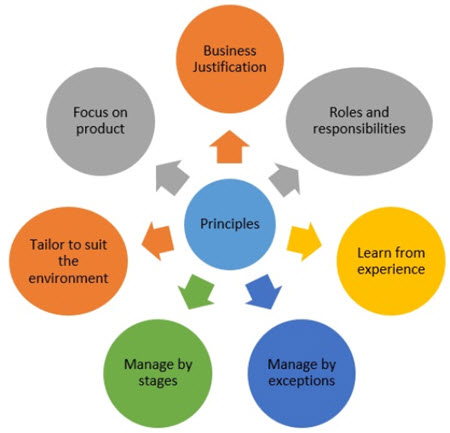Contents
The CORE Principles of PRINCE2 are the seven components of a mindset that helps keep the project aligned with PRINCE2 mehtodology.
Defined roles and responsibilities
 An important principle of PRINCE2 is clearly defined and assigned roles with corresponding responsabilites.
An important principle of PRINCE2 is clearly defined and assigned roles with corresponding responsabilites.
The roles are structured in four levels:
- Corporate or programme management level
- Project board level
- Project manager level
- Team level
It is possible for an individuals to take on multiple roles, and it is also possible for two or more individuals to share a role.
Continued business justification
The business case document is a very important document that must be updated at every stage of the project. This makes it easier to monitor if the project is still viable, and abort or adjust the project if non-viability occurs.
Manage by stages
In PRINCE2, projects are planned and controlled on a stage-by-stage basis.
When a move occurs from one stage to the next, it always involve updating the business case, risks, overall plan, and next-stage plan.
Manage by exception
In PRINCE2, work packages are assigned by team manager to team members, including deliverables with time and quality tolerances.
This makes it possible to avoid wasting resources on routine meetings, e.g. weekly team meetings that are held regardless of their necessity and usefulness.
If a deliverable exceeds the assigned tolerances, communication between team manager and team member(s) will be required, e.g. in the form of a meeting.
Focus on products
Each work package is defined by one or more deliverable products.
Responsability for delivering the package and controlling the package should be clearly assigned.
Quantified tolerances are given for each work package, e.g. when it comes to time, quality, scope, and cost.
Important: Management activities, such as stage planning, should also be defined by their final output. The output can for instance be a report containing the new stage plan.
Learn from experience
A lesson log must be kept for each project.
During a project, participants should regularly check lesson logs (for this project, for other current projects, and for previous projects) to avoid reinventing the wheel.
Tailor to suit project environment
PRINCE2 should be tailored to fit each project. It is not recommended to utilize PRINCE2 in a dogmatic way.
Example:
- For certain parts of a project, verbal communication or e-mail communication might be better than formal reports.
- For a research-intensive project, extra resources might need to be assigned to stage replanning, since directions might have to be altered as new data is delivered.
- The ideal structure of the project board or management team may vary from one project to the next.
